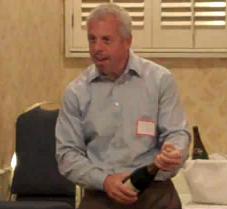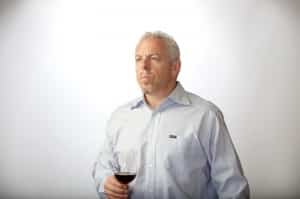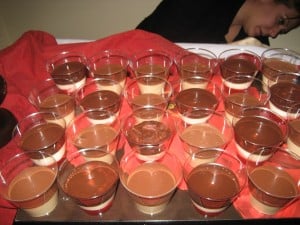Posts Tagged ‘wine and food pairing’
Consider Yourself Paired – “Yinzer Torte”!
First of all, I want to mention that it’s really great that Daniel is using local resources as his ingredients. It’s really sad that people are so urbanized and removed from nature that they don’t even trust the fruit that grows on their local trees! Just like Daniel used the local quinces for this recipe, I have often thought about using the ginkgo “stinky” fruit that falls from the female trees that are common all over Washington, D.C. Stinky Gingko Fruit – unfortunately, it is SO stinky, that it will probably never happen!
The first point I want to make is that I am not a proponent of pairing dessert wines and dessert – the way I see it, there’s a missing synergy. In my book (sorry for the blatant promo!) I Drink on the Job – I have a complete chapter on pairing wine and food, and the principle that comes to mind is “1+1=1/2”. It seems weird, but when you put a sweet food in your mouth and then you drink a sweet beverage (it could be any beverage – fruit juice, cola, etc.), the sweetness is significantly reduced. The pairing rule I often learned was that the wine should be at least as sweet at the dessert, but I don’t see how it makes a difference – sweet and sweet mostly cancel each other out!
Another point is that the Yinzer torte is made with highly acidic quince fruit turned into a butter emulsion. So now you have acidity – and yes, you do want to match a dishes acidity with the wine, or the wine will taste really flat! You could easily pair this dish with a traditional dessert wine like a Sauternes or a Hungarian Tokaj, and that will do just fine. But let me throw a curve ball.
1) I prefer to have contrast to a sweet dessert dish – just like many people really enjoy coffee with sweets because the tannin in coffee contrasts the sweetness of dessert on your palate, I would rather pair this with a spirit – and my spirit of choice for this dish is either a Cognac or a Calvados. Cognac is distilled from grapes and has a nice fruit component. Calvados is distilled from apples and has that fruit component as well. You could have a whisky or a Scotch, but definitely avoid a really smoky/peaty version of the latter – there are no smoke components to this dessert (unless you’re puffing on a cigar at the time!),
2) Change the dish a bit to make it go better with wine – this is called a pairing “bridge”. For example, you could put some chopped walnuts on top and maybe serve with a slice of blue cheese and now Ruby Port goes perfectly! Crunchy nuts would also add texture which makes food more interesting on the palate. Add a caramel sauce, and now a Tawny port, which is port that has been pre-aged in barrel will work with those flavors. You could even bridge this dessert by making a dessert wine reduction, and that would bring the flavors together.
3) Add fresh whipped cream with a little liqueur in it like Cointreau. OK, it won’t match better with any wine, but certainly it will make the dish all the better, and isn’t pleasure what you’re really after?
Consider yourself paired!
Charlie Adler, Author, I Drink on the Job
If You Evaluate Wine, Then Why Not Food?
This was a crazy week for me, so I’m just starting to wind down and think about it more. I was on the “Thunder Show” with Gary V on Monday (although it went up on Wednesday), traveled back to DC through the snow and began in earnest to market my book the rest of the week, with a small respite for a “Unique Spirits 101” class that I organized with my full-time gig TasteDC. I always like to look back at my week and try to sift through what was important, what I learned and if I need to avoid any situations. I sort of live in a bubble – all I care about is promoting my message – wine and food were meant to be together – and that’s become my life goal, better not get in the way!
I love wine, and I love food, so I’m in a bit of a quandary (a common state for me!)..why is it in the wine world that we try to evaluate and break down wine, but in the food world, it only happens in rare occasions such as competitions..a little vague, but let me explain. Whenever I’m teaching a class on wine like my “Wine Basics 101” class at TasteDC, attendees always ask me to “explain” what I’m tasting. People who are attending a wine class obviously want to learn more about wine, but I’m not sure why they want to know what I’m tasting – does it translate well to their taste buds? If I taste spearmint, blackberry and tobacco, and you taste peppermint, cranberry and honey, who’s right? By breaking down the components of the “taste” of wine, do I make it any easier for a beginner wine drinker to understand the wine? Will the attendee be empowered by the experience or intimidated, and ultimately, will it get the person to purchase more wine?
First of all, I don’t have the answer, that’s why I’m in a quandary – there is no answer, sometimes just looking at the question brings awareness to the situation (my Zen side!). So I posed an additional question to myself: if we break down wine into its individual parts, shouldn’t we do so for food as well? In my book “I Drink on the Job” I spend alot of time talking about the connection between food and wine. I have one quote – read it, consider it, make a picture of it in your mind:
Americans don’t seem to trust their sense of taste with wine. If you like steak, then you don’t need anyone to tell you if it’s good or not; you’ve enjoyed steak since you were young and you know what you like–medium or medium-rare, one-inch thick, two-inch, rib eye, filet or strip–even if someone else disagrees. We have no experience with wine as a culture, so we seek peer approval..
I Drink Launches on Wine Library TV with Gary V!
Charlie Adler with Gary Vaynerchuk on Official Launch of “I Drink on the Job” Book
OK, time for “I Drink on the Job”s 15 minutes of fame..it all started on a cold rainy day, windswept and forlorn..
Actually, I met Gary V on his “Crush It” book tour when he visited American University in Washington, D.C.
Crush It has had a huge influence on my book marketing via Social Media..
I give Gary V credit, he’s a very savvy guy, and being on the show is about the most exhilarating experience I’ve ever had,
I mean it’s like an emotional roller-coaster, it was scary and fun at the same time!
I’ll have more on this tomorrow – I’m watching I Drink Amazon.com Sales go through the roof!!
Chocolate and Wine: A Pairing for Sweeties!
I love chocolate..I love wine..but can the two come together to make a great match? This is the dilemma of writing a chocolate and wine pairing article – it is not a “traditional” pairing, meaning, it is neither a regional pairing (Loire Valley Sauvignon Blanc and Chevre) nor a dish pairing such as steak and Cabernet Sauvignon. Chocolate and wine pairing was created primarily to satisfy the need for accentuating and justifying the obvious connection between being amorous and enjoying the sensual pleasures of chocolate and vino!
Actually, the pairing can work, so here’s my take on the combination. First, the assumption is you’ll be tasting dark chocolate, in other words, chocolate with say 60% or more Cacao percent. Dark chocolate or “bittersweet” chocolate has two components to think about: tannin (from the cacao bean) and sugar. The basics of food and wine pairing are either to pair similar or contrasting components. For example, since chocolate has tannin and red wine has tannin, you could pair those flavors. The effect of pairing similar tastes is actually to lessen each, also known as “1+1=1/2”. Take too similar “tastes” paired together and that component will be lessened. Tannin and tannin reduce the effects of each other. This same principle works with the sugar in chocolate and the sugar in a glass of wine, again the same thing, this will ultimately make both seem less sweet. This is a weird phenomenon, but try something basic like orange juice and a sweet morning muffin, and it becomes obvious.
If you contrast with your pairing, the most obvious is to pair a highly acidic wine with chocolate to counterbalance the tannin and/or sweetness. In my opinion, this won’t work very well because it would be an unnecessary overload of the senses. Plus, I’ve tried it, and it tastes pretty awful or neutral at best!
So you have a choice: you can either pair the sweetness with a dessert wine such as a French Sauternes or a German dessert Riesling or you can pair the tannin in chocolate with a red wine with tannin. For whatever reason, many Merlots and also fruity medium tannin wines work with chocolate. Merlot is generally medium tannin, but also has softer, lusher tannins that don’t seem to clash with chocolate.
So what’s my conclusion after evaluating the chocolate and wine pairing principles? Frankly, it’s better to just go with the romantic mood, forget the pairing and enjoy some delicious Champagne or sparkling wine with chocolate! My reasoning is the power of suggestion: sparkling wine suggests a special occasion, from the popping of the cork to the effervescence of the wine, and it promotes the romantic occasion.
You could play with the sparkling wine a bit by serving a Rosé which often is made from lightly pressed and fermented Pinot Noir. The best pairing might be Port which has both tannin from the red grapes as well as sweetness from sugar. My issue with Port is that from experience, many Americans aren’t fond of it, especially at tastings I’ve held, it is often over powering to an unaccustomed palate.
Conclusion: wine and food pairing shouldn’t get in the way of a romantic moment, they should accentuate it. Dessert wines work great with the sugar of chocolate, Port is even better, but medium tannin wines like Merlot also work well..still, Champagne or sparkling wine wines. Celebrate love and romance with a bottle of bubbly and share the moment!
"I Drink on the Job" – DONE! Off to the Printers..

Charlie Demonstrating Screwtop Sniffing Technique!
My book is done – off to the printers! I received the Author’s Proof copy in the mail yesterday of “I Drink on the Job: A Refreshing Perspective on Wine” and I went through it thoroughly – found a few typos, but I felt it was good to go – Onward!! So do I feel relieved? Well kinda, let me explain:
First of all, now that the book is done, now I have to sell it! Oh, you mean these things don’t just sell themselves, shouldn’t I just sit back and wait for the royalty checks? After talking with quite a few first time authors, this myth was quickly erased for me. Marketing, promoting and selling a book today is a jungle – you gotta go out there with your machete and cut through all the brush in order to get to your sales paradise. I’ve been talking up the book for about a year now (according to my estimate, the book was finished about 8 months ago!) and I even held a pre-launch through Adams Morgan Main Street, a non-profit that was interested in having me speak at their monthly wine tasting. My formal “Launch” is on Wine Library TV on Monday, February 15th in a few weeks, but I still have pretty wide open plans.
I’ve signed up to be one of the wine seminar speakers at various wine and food festivals in the DC area including Great Grapes, Virginia Wine Showcase, and many more in Virginia and Maryland. The DC Intl. Wine Festival no longer has wine seminars, but I will be attending (still waiting for my Trade/Press pass, what’s up with that DC Fest??). I’m talking with various local wine retailers (a few national chains too!) and wine bars for events as well. When I charged speaker’s fees for wine tastings before, I cut out so many charities who couldn’t afford my services, now all they have to do is purchase a minimum number of books and they have an event to go!
I REALLY strained my sciatic nerve really bad lifting weights this week, and I can barely walk without wincing in pain – ouch!! I think that injury is related to stress – I had too much on my mind when I hit the gym and I hit it a bit too hard. If someone says you can’t be “over” motivated, they’re flat out wrong – I’m capable of losing a limb without noticing when I’m pumped up..but I really need to take it easy at my age (40+ – that’s all you need to know!), I have to be the turtle, not the hare..
OK, back to watching the snow fall in DC and wondering how to market my first book – questions like “where should I do a book tour?”, “will wine bar events sell books?” and “did I price my book right?” are all floating happily in my brain – think I’ll relax in front of the fire tonight – Cheers!
Charlie “I Drink on the Job” Adler
Wine: The Food Enhancer
Spice up your life! If you enjoy food, then wine will come naturally. It’s part of the seasoning of your meal. Think of wine as a way to enhance the flavors of food. As a full-time wine professional over at TasteDC and about to be released author of I Drink on the Job: A Refreshing Perspective on Wine I constantly get questions from new wine drinkers about food and wine pairing. My overall philosophy is that wine and food is a synergy: 1 + 1 should equal MORE than 2. I argue that this is the same way with spices and the cooking preparation of your dish. Chefs will often add spices and taste as they go which helps to layer flavors and adjusts the flavor of the dish. Wine has dual purposes as well: it wakes up your taste buds before you begin eating primarily with acidity, and it accentuates flavors in food. If this sounds complicated, remember – no one has ever died from a bad wine and food pairing, it’s a low-risk proposition, even if wine and food don’t pair well, you can still experience pleasure!
My suggestion is that since wine and food pairing is an art form at best, wine consumers should experiment. What works for you, may not work for me and vice-versa. Just as chefs are adding new combinations of spices and flavorings to their dishes, new wine and food pairing synergies will be discovered. I like to think of it as exploration – new adventurers are breaking out of the mold of old ways of thinking and discovering new ways to enjoy the pleasures of wine. Just like not every explorer discovered something of value or importance, not all wine and food matches will work. But why not experiment and possibly make a discovery? The world of wine and food adventures is much safer than crossing the Atlantic on a galley, the worst mutiny that could occur is wine critics and the wine “order” could ignore you or denigrate you, but with the new world of social media – who needs them anyway? Set sail my friend to a new world of Tasting Discovery – Cheers!
Charlie “I Drink on the Job” Adler
Debunking Terroir

I’ve heard so much about terroir in the wine press/blogging/twitter the last few years, that I’m past overwhelmed by all the statements and now into my denial phase. If you’re not familiar with “terroir”, it’s all about the “placeness” of a wine: the what, where, and how of the type of vine chosen, the varietal, the roots, the soil, the micro-climate, the wine maker, the regionality and of course all the factors that go into making the wine. For example, the “terroirists” or proponents of the idea that wine (and cheese, and beer, and pretty much anything you consume) should represent the unique characteristics of its region, are generally against much human manipulation, ie. chemical fertilizers, fungicides, herbicides, and too much use of new oak (this is a very short list, there are many more!). Their thinking is that we should taste nature’s gift the way nature intended it to be–use natural yeast, don’t filter or fine, and let the grapes ferment and express themselves the way they were meant to..enough, enough!
So what’s my issue with the concept of terroir? Does my skepticism towards the idea that you can (or can not) taste the soil in the final expression of the wine give me the right to throw the whole idea of nature’s expression out the window? Well, that’s not my point. I actually believe that better wine makers know and understand the locality they live in and they should use the least aggressive means of getting the vine to ripen grapes and express the full range of flavors. I believe that terroir, like character, is personal to each wine consumer. We each HAVE our own terroir (where you were born, your family history, the way you were brought up, etc.) and VIEW terroir differently – you say tomato, I say tomaato, well..you get the picture. We all express our own terroir, taste things in our own way, and we should each express our own opinions. The terroirists like many idealists are just too fanatical for my tastes, so to speak. They often condemn “manufactured wines” that have no soul, no individuality, and don’t represent a unique micro-climate. Fine–but just like the average American consumer, I want to enjoy a wine and I want it to taste good – what if 2 Buck Chuck tastes better to my palate than a $45 bottle of Burgundy, does that make me insincere? Isn’t there a place for mass market wines just like there’s a place for chain stores, or other commercially made products? Sure, I prefer handmade chocolates, but I’m not offended by the highly industrialized manufacture of Hershey Kisses, hey they taste good too!
The French say “to each his own” – so be it with wine. You only buy grass-fed organic beef from the farmer’s market, I like Prime-Aged corn-finished meat, but my mother swears by the tenderloin at Costco. Same with wine, each of us has different needs and goals in mind, so that should sincerely respected. I’d rather drink a local Virginia or Maryland wine (non-organic – it’s not possible at this point to produce organic wines in our area primarily due to humidity and rainfall during harvest issues) than an organic wine from say Chile. Both wines are great, but I can see the face of the Virginia winemaker at a local wine tasting room or at local tastings. I like the idea to keep money in the community when possible – that’s my feel good issue. For me, my sense of terroir is connected with the people I help in life – economically, spiritually, and in whatever way I can be of assistance. I don’t give money to international charities because I try to assist the homeless that live within a mile of a my home. My terroir is right here..
Charlie “I Drink on the Job” Adler
How to Pop

Charlie Adler, Author of I Drink on the Job” Popping the Champagne Cork Video!
I’ve probably opened more than 2,000 bottles of sparkling wine – that excludes Belgian beers and Real Ciders.
Believe it or not, the secret is in the knees – bend them just a bit..for whatever reason, whether it’s psychological or physics, this makes easing the cork out less cumbersome. I have to admit – sometimes the cork does fly out – even when you use the precautions mentioned in the video – ironically, this happened to me at the Embassy of Switzerland in Washington, D.C. when I attempted to open some VERY fizzy Swiss wines.
Enjoy the video – I think you’ll find that opening a bottle of sparkling wine is relatively easy and care-free!
Cheers!
Charlie “I Drink on the Job” Adler









